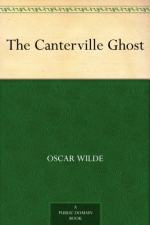|
This section contains 1,470 words (approx. 4 pages at 400 words per page) |

|
Lutz is currently teaching writing at the New York University School of Continuing Education. In the following essay, she examines the importance of masks and performances in "The Canterville Ghost."
Many critics of Oscar Wilde's "The Canterville Ghost" find dark and profound meanings beneath what Philip K. Cohen calls in The Moral Vision of Oscar Wilde "the camouflage of hilarity." Cohen argues that this seemingly light ghost story "faithfully renders Wilde's life during the mid 1880s," a time when Wilde, by necessity was leading a double life. By 1886, he was involved in a homosexual relationship with Robert Ross and had also been married for two years. Both his marriage and the social mores of late Victorian England demanded that Wilde hide his affair.
In "The Canterville Ghost," Cohen finds Wilde almost confessional, condemning the wearing of masks and the "radical discrepancy between the self-or, more accurately, selves-he...
|
This section contains 1,470 words (approx. 4 pages at 400 words per page) |

|




